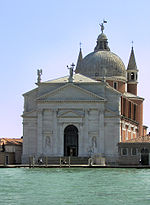San Clemente, Venice
Renaissance architecture in VeniceRoman Catholic churches in Venice
The Church of San Clemente (Chiesa di San Clemente) is a church built in 1131 and located on San Clemente Island, in the Venetian Lagoon. The name is dedicated to Pope Clement I, who died as a martyr according to legend and who is patron of seamen.
Excerpt from the Wikipedia article San Clemente, Venice (License: CC BY-SA 3.0, Authors).San Clemente, Venice
Calle de la Croce, Venice Venezia-Murano-Burano
Geographical coordinates (GPS) Address External links Nearby Places Show on map
Geographical coordinates (GPS)
| Latitude | Longitude |
|---|---|
| N 45.4121 ° | E 12.3356 ° |
Address
Chiesa di San Clemente
Calle de la Croce
30170 Venice, Venezia-Murano-Burano
Veneto, Italy
Open on Google Maps









